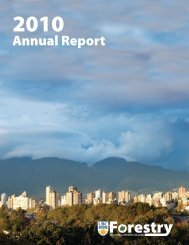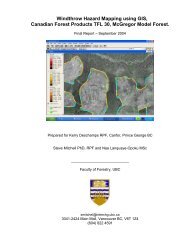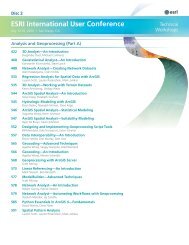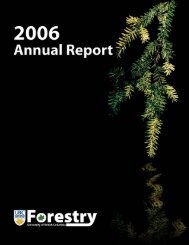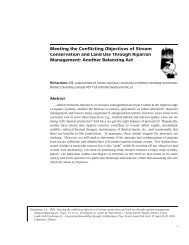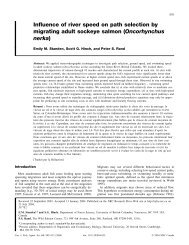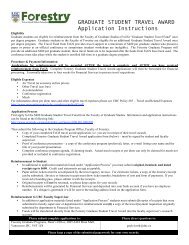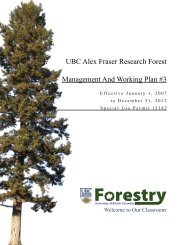A Four-year Summary of Breeding Bird Surveys in TFL 48 ... - BIOD
A Four-year Summary of Breeding Bird Surveys in TFL 48 ... - BIOD
A Four-year Summary of Breeding Bird Surveys in TFL 48 ... - BIOD
You also want an ePaper? Increase the reach of your titles
YUMPU automatically turns print PDFs into web optimized ePapers that Google loves.
<strong>in</strong> how and where historical <strong>Breed<strong>in</strong>g</strong> <strong>Bird</strong> <strong>Surveys</strong> data were collected, it is more likelythat differences <strong>in</strong> abundance are related to differences <strong>in</strong> the methodology used tocount birds, and the types <strong>of</strong> habitats sampled. First, specific details regard<strong>in</strong>g transectlocations are largely unknown, except that they are generally restricted to suburban andlow-ly<strong>in</strong>g rural areas, <strong>of</strong>ten along primary or secondary highways. In these sett<strong>in</strong>gs, wemight expect total abundance and richness to be greater because <strong>of</strong> the greaterassociation <strong>of</strong> communal or gregarious species <strong>in</strong> those environments (e.g., Black-billedMagpie, American Crow, European Starl<strong>in</strong>g, House Sparrow, Rock Dove, variouswaterfowl species, etc). Second, the type <strong>of</strong> habitat along highways <strong>in</strong> lowland areas(where farm<strong>in</strong>g and <strong>in</strong>dustrial operations take place) is markedly different compared tothat found <strong>in</strong> areas managed for timber extraction, especially at higher elevations.Consequently, bird communities are likely to differ, support<strong>in</strong>g fewer communal orgregarious species (i.e., only P<strong>in</strong>e Sisk<strong>in</strong> and crossbill spp. aggregate <strong>in</strong> forested areas<strong>of</strong> <strong>TFL</strong> <strong>48</strong>, with annual numbers fluctuat<strong>in</strong>g substantially with cone or seed cropproduction). Lastly, the survey protocol for <strong>Breed<strong>in</strong>g</strong> <strong>Bird</strong> <strong>Surveys</strong> was largely avolunteer effort with a wide range <strong>of</strong> skills and abilities. Coupled with non-standardizedmethods for count<strong>in</strong>g birds (i.e., unlimited distance estimates) and limited habitat<strong>in</strong>formation for that period, comparisons, and subsequent relevance to forestry, islargely limited.Conclud<strong>in</strong>g RemarksFrom 2002 – 2005, 15 and seven transects were established <strong>in</strong> <strong>TFL</strong> <strong>48</strong> and theFort St. John TSA, respectively. Additionally, GPS data was acquired for 1,070 surveystations for the purpose <strong>of</strong> creat<strong>in</strong>g and test<strong>in</strong>g BEC subzone representation, BEC26




